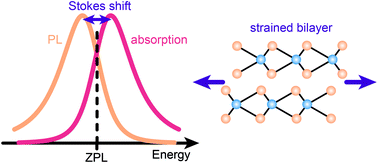Strain tuning of the Stokes shift in atomically thin semiconductors†
Abstract
Atomically thin layers of transition metal dichalcogenides (TMDC) have exceptional optical properties, exhibiting a characteristic absorption and emission at excitonic resonances. Due to their extreme flexibility, strain can be used to alter the fundamental exciton energies and line widths of TMDCs. Here, we report on the Stokes shift, i.e. the energetic difference of light absorption and emission, of the A exciton in TMDC mono- and bilayers. We demonstrate that mechanical strain can be used to tune the Stokes shift. We perform optical transmission and photoluminescence (PL) experiments on mono- and bilayers and apply uniaxial tensile strain of up to 1.2% in MoSe2 and WS2 bilayers. An A exciton red shift of −38 meV/% and −70 meV/% is found in transmission in MoSe2 and WS2, while smaller values of −27 meV/% and −62 meV/% are measured in PL, respectively. Therefore, a reduction of the Stokes shift is observed under increasing tensile strain. At the same time, the A exciton PL line widths narrow significantly with −14 meV/% (MoSe2) and −21 meV/% (WS2), demonstrating a drastic change in the exciton–phonon interaction. By comparison with ab initio calculations, we can trace back the observed shifts of the excitons to changes in the electronic band structure of the materials. Variations of the relative energetic positions of the different excitons lead to a decrease of the exciton–phonon coupling. Furthermore, we identify the indirect exciton emission in bilayer WS2 as the ΓK transition by comparing the experimental and theoretical gauge factors.



 Please wait while we load your content...
Please wait while we load your content...